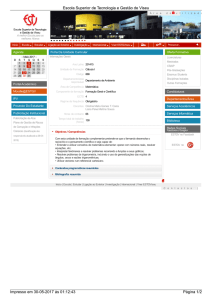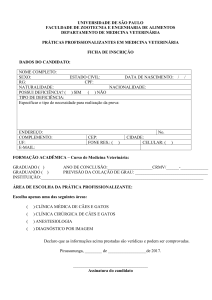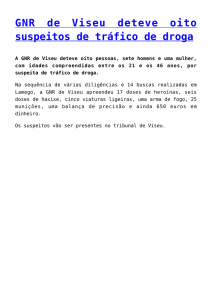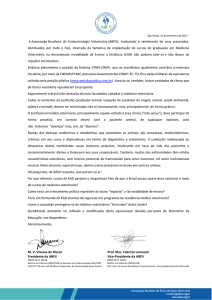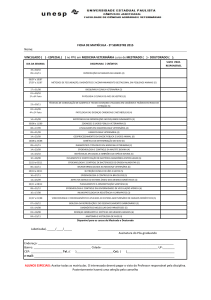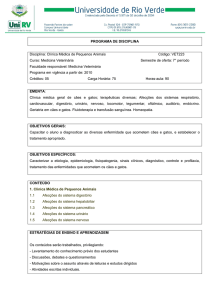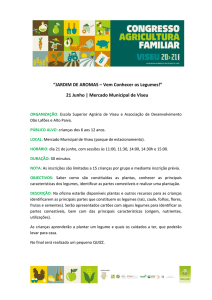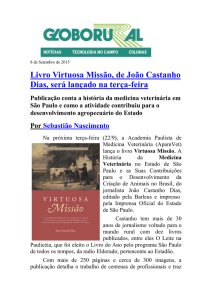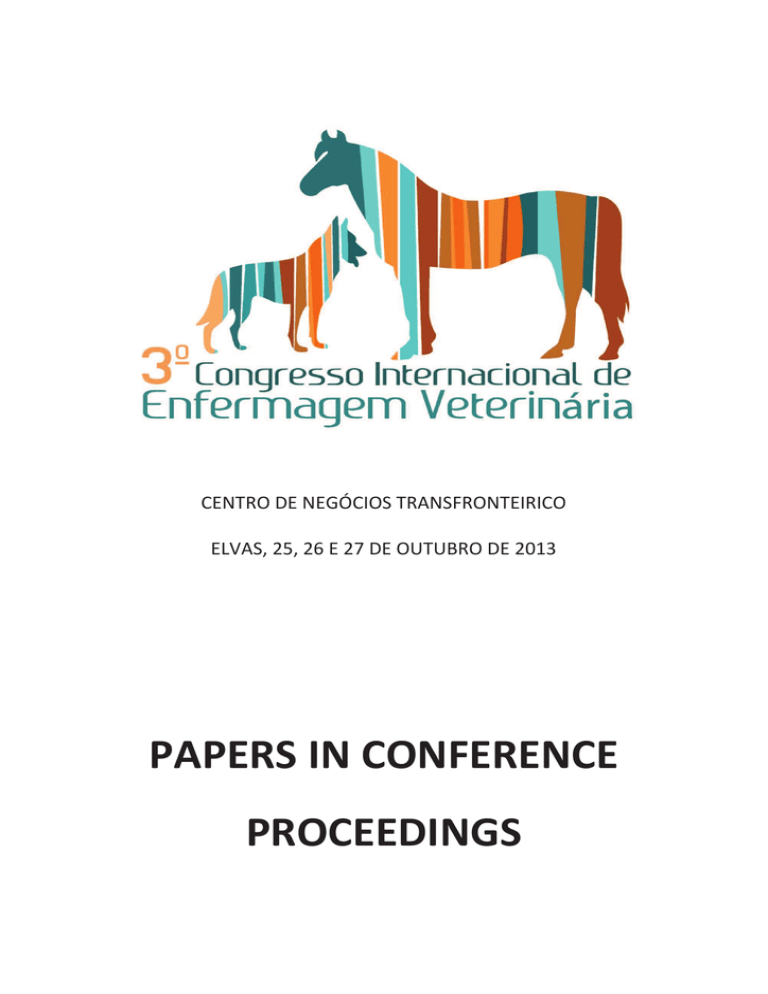
CENTRO DE NEGÓCIOS TRANSFRONTEIRICO
ELVAS, 25, 26 E 27 DE OUTUBRO DE 2013
PAPERS IN CONFERENCE
PROCEEDINGS
3º CONGRESSO INTERNACIONAL DE ENFERMAGEM VETERINÁRIA – ELVAS, 25, 26 E 27 DE OUTUBRO DE 2013
005. CANINE AND FELINE ORAL PATHOLOGY
Costa S1, Pais B1, Almeida D1, Simões J1, Mega AC1, Vala H1,2
1-Escola Superior Agrária de Viseu, Instituto Politécnico de Viseu. Quinta da Alagoa.
Estrada de Nelas. 3500-606 Viseu. Portugal
2- Centro de Estudos em Educação, Tecnologias e Saúde, Escola Superior Agrária de
Viseu, Instituto Politécnico de Viseu. Estrada de Nelas, Quinta da Alagoa, Ranhados,
3500-606 Viseu, Portugal
Presenting author: [email protected]
INTRODUCTION
The aim of this work was to present a brief review of the main conditions affecting the
oral cavity of dogs and cats. In recent years there has been increased attention with
regard to veterinary dentistry, being several and frequent the pathologies located in
the oral cavity of our pets. These diseases mainly affect the teeth and the mucous
membranes of the oral cavity, and may, in chronic cases, also affect vital organs. This
condition could have different causes, including hereditary, congenital, infectious,
tumoural and even traumatic, requiring specific therapeutic approaches (Bellows,
2010; Holmstrom et al., 2007).
RESULTS
GINGIVITIS
Gingivitis is an early oral conditions, in which only the gums are involved, which are
presented red, swollen, and may bleed to the touch. This state is reversible and if the
animal makes a tartarectomia, leaving all the clean tooth, the gums will return to
normal (Bellows, 2010; Holmstrom et al., 2007).
9
3º CONGRESSO INTERNACIONAL DE ENFERMAGEM VETERINÁRIA – ELVAS, 25, 26 E 27 DE OUTUBRO DE 2013
PERSISTENCE OF DECIDUOUS TEETH
As its name indicates, this pathology is associated with the eruption of permanent
teeth without the prior corresponding fall in deciduous. In dogs between 5 and 7
months, and cats between 6 and 12 months all the teeth will already have been
replaced. The non-occurrence of this natural replacement called persistence of
deciduous teeth, may have cause to be genetic in origin (Niemiec, 2008). The
treatment consists in the extraction of corresponding deciduous tooth (Bellows, 2010;
Holmstrom et al., 2007; Niemiec, 2008).
DENTAL FRACTURES
Are mainly caused by accidents, pedestrian accidents, falls from great heights or
trauma resulting from the hunting activity. As the periodontal bacteria can reach the
bloodstream and cause irreversible damage to vital organs such as the kidneys, liver
and heart. Most cases require tooth extraction (extraction) or performing endodontic
treatment chewing and allowing the seizure (Bellows, 2010, Holmstrom et al. 2007).
The tooth is disinfected in its interior, removing all infected and necrotic material, and
then filled with a filling material and restored with resin, amalgam or metallic
prosthesis (Bellows, 2010, Holmstrom et al. 2007).
GINGIVAL HYPERPLASIA
Gingival hyperplasia is an overgrowth of the gums, characterized by the gradual
increase in its thickness, especially at the level of the gingival board as well as the
presence of bodies firm and not painful. The cause is unknown, and the most common
signs of halitosis (bad breath), excessive salivation, dysphagia (difficulty ingesting food)
and bleeding in severe cases. It is a recommended gingivoplasty in order to regain
normal gingival thickness and contour (Bellows, 2004; Holmstrom et al., 2007).
10
3º CONGRESSO INTERNACIONAL DE ENFERMAGEM VETERINÁRIA – ELVAS, 25, 26 E 27 DE OUTUBRO DE 2013
PERIONDONTITE
This condition results primarily from progression of gingivitis, gum infections resulting
in severe with the formation of pus, alveolar bone demineralization or abnormal
growth and shrinkage of the gum (gingival hyperplasia). Bacteria run throughout the
body and can reach vital organs such as the heart, liver, kidneys, lungs, joints, and
meninges (Youle, s / d).
The treatment consists of a scraping with dental ultrasound and hand curettes and if
any exposed roots, are properly scraped and flattened, and then all the teeth polished.
In more severe cases, we resort to intraoral radiography or tooth extraction (Bellows,
2010; Holmstrom et al., 2007).
HYPOPLASIA AND HYPOCALCIFICATION ENAMEL
The teeth are the teeth enamel defects with a predisposition to periodontal disease
onset, this is because the surface is uneven, and the majority of cases its rough texture
and thereby facilitating the development of plaque. Also in areas where the enamel is
absent or underdeveloped, the tooth is more fragile and conducive to fracture (Huttly
et al., 2003; Niemiec, 2008). These defects are irreversible so your greatest ally is
prevention!
ORTHODONTIC CHANGES
Orthodontic changes may be related to genetic / hereditary, as well as trauma and
retention of teeth. An incorrect conformation dental trauma can cause the gums or
palate, leading later to a communication with the nasal cavity (Wenceslas & Zainaghi,
2011).
To address such deficiencies, the existing solution is to use an orthodontic appliance
(Holmstrom et al. 2,007; Wenceslas Zainaghi & Ana, 2011).
11
3º CONGRESSO INTERNACIONAL DE ENFERMAGEM VETERINÁRIA – ELVAS, 25, 26 E 27 DE OUTUBRO DE 2013
DEFECTS IN PALATE
A cleft palate, also called palatal defect, is a abnormal communication between the
oral and nasal cavities and oral and maxillary sinus. The palatal defects may be
congenital or acquired during life. The main causes are: trauma, dental disease, bite
wounds and penetration by foreign bodies. These animals have difficulty
breastfeeding, nasal regurgitation, failure to thrive and growth, respiratory infection,
drainage of milk during breastfeeding nostrils, coughing, gagging and sneezing (Lawall,
2012). The correction involves the reconstructive surgery of the palate (Bellows, 2010;
Holmstrom et al., 2007).
MAXILAR AND MANDIBULAR FRACTURE
Fractures at the upper and lower jaw (mandible) are, in most cases, lesions due to
trauma. There are some common signs, such as facial disfigurement, oral or nasal
bleeding, inability to open or close the jaw and fractured teeth (Bellows, 2010;
Holmstrom et al., 2007).
Surgery is the most common treatment, with the ultimate goal of reducing the
fracture, establishing the natural occlusion of bones and teeth (Bellows, 2010;
Holmstrom et al., 2007).
SIALOCELO
It is one of the most common disorders based in the salivary glands observed in dogs.
This occurs due to leakage of saliva into the subcutaneous tissue of the jaw and neck
or ventral to the interior tissues sublingual and pharyngeal tissues. The main cause is
due to trauma located in the gland duct concerned. Clinical signs include a painless
swelling in the neck and pharyngeal dysphagia. Sometimes, it is the aspiration of the
accumulated fluids or complete removal of the sublingual salivary gland affected
(Caiafa, 2007).
12
3º CONGRESSO INTERNACIONAL DE ENFERMAGEM VETERINÁRIA – ELVAS, 25, 26 E 27 DE OUTUBRO DE 2013
DISCUSSION AND CONCLUSION
The salivary gland disorders, cancer and periodontal diseases are diseases of the oral
cavity most common and affect most of our pets (Bonello, 2007; Niemiec, 2008). Many
of these diseases go unnoticed by the owner, only being detected at a later stage after
the onset of symptoms, but also when the treatment methods to reverse these
conditions are no longer effective, and as such, in most cases uses to a tooth extraction
(Bellows, 2010; Bonello, 2007; Holmstrom et al., 2007; Niemiec, 2008). Therefore, and
despite a major concern of homeowners in modern society with the health and
welfare of animals, the problems of the oral cavity still often getting sent to a second
plane (Huttly et al., 2003; Niemiec, 2008).
It is our understanding and intention to contribute to this work, so that the domain
knowledge of these diseases by veterinary nurse, will contribute to an improvement in
the early detection of the same but especially to strengthen the role of the veterinary
nurse in prevention and control, with practical and effective recommendations
regarding oral hygiene measures that the owner must implement at home or to be
applied in the context of query (Huttly et al., 2003).
BIBLIOGRAPHY:
Bellows J (2004). Small animal dental equipment, materials and techniques. A primer.
Blackwell Publishing, Iowa, EUA, 417 pp..
Bonello D (2007). Feline inflammatory, infectious and other oral conditions. Tutt,
Cedric; Deeprose, Judith; Crosseley, David. BSAVA (3ªedição). 126-145.
Caiafa A (2007). Canine infectious, inflammatory and immune-mediated oral
conditions. Tutt, Cedric; Deeprose, Judith; Crosseley, David. BSAVA (3ªedição). 96-123.
Holmstrom, Fitch F, Eisner R (2007). Veterinary dental techniques for the small animal
practitioner. 4ª Edição, Mosby Elsevier, Filadélfia, EUA, 689 pp.
Huttly S,Taylor I, Sweet J (2003). Effective learning & teaching in medical, dental &
veterinary education. Sterling, VA, 101pp.
13
3º CONGRESSO INTERNACIONAL DE ENFERMAGEM VETERINÁRIA – ELVAS, 25, 26 E 27 DE OUTUBRO DE 2013
Lawall
T
(2012).
Fenda
Palatina
http://thaisevet.blogspot.pt/2012/07/fenda-palatina-congenita.html,
Congênita.
consulado
a
15/11/2012.
Niemiec A (2008). Topics in Companion Animal Medicine. Elsevier Inc. 59-71; 72-80.
Venceslau, Zainaghi A. (2011). Cachorro também usa aparelho nos dentes.
Sabia?.http://entretenimento.r7.com/bichos/noticias/cachorro-tambem-usa-aparelhonos-dentes-sabia-20111130.html?question=0, consultado 10/11/2012.
Youle C (s/d). Periodontopatias ou Doenças Causadas pelo Tártaro em Cães.
http://www.dogtimes.com.br/saude8.htm, consultado a 16/11/2012.
ACKNOWLEDGMENT: FCT&DETS (PEest-OE/CED/UI4016/2011).
14
3º CONGRESSO INTERNACIONAL DE ENFERMAGEM VETERINÁRIA – ELVAS, 25, 26 E 27 DE OUTUBRO DE 2013
006. PATOLOGIAS DA CAVIDADE ORAL EM CANÍDEOS E FELÍDEOS
Costa S1, Pais B1, Almeida D1, Simões J1, Mega AC1, Vala H1,2
1-Escola Superior Agrária de Viseu, Instituto Politécnico de Viseu. Quinta da Alagoa.
Estrada de Nelas. 3500-606 Viseu. Portugal
2- Centro de Estudos em Educação, Tecnologias e Saúde, Escola Superior Agrária de
Viseu, Instituto Politécnico de Viseu. Estrada de Nelas, Quinta da Alagoa, Ranhados,
3500-606 Viseu, Portugal
Autor apresentador: [email protected]
INTRODUÇÃO
Pretende-se neste trabalho apresentar uma breve revisão das principais condições que
afetam a cavidade oral dos cães e gatos. Nos últimos anos tem-se verificado uma
maior atenção no que toca à odontologia veterinária, sendo que são várias e
frequentes as patologias da cavidade oral dos nossos animais de companhia. Estas
patologias afetam principalmente os dentes e a mucosa da cavidade oral, podendo, em
casos crónicos, afetar também órgãos vitais. As doenças podem ser de natureza
diversa: hereditárias, congénitas, infeciosas, tumorais e até traumáticas, requerendo
cada uma delas cuidados específicos para o seu tratamento (Bellows, 2010; Holmstrom
et al., 2007).
RESULTADOS
GENGIVITE
A gengivite é uma das condições orais iniciais, em que apenas estão envolvidas as
gengivas, as quais se apresentam avermelhadas, inchadas, podendo sangrar ao toque.
Este estado é reversível e caso o animal faça uma tartarectomia, deixando todo o
dente limpo, a gengiva retornará ao normal (Bellows, 2010; Holmstrom et al., 2007).
15
3º CONGRESSO INTERNACIONAL DE ENFERMAGEM VETERINÁRIA – ELVAS, 25, 26 E 27 DE OUTUBRO DE 2013
PERSISTÊNCIA DOS DENTES DECÍDUOS
Como o próprio nome indica, esta patologia está associada à erupção dos dentes
permanentes sem uma prévia queda dos decíduos correspondentes. Nos cães, entre
os 5 e 7 meses, e nos gatos entre os 6 e 12 meses todos os dentes já deverão ter sido
substituídos. A não ocorrência desta substituição natural designada por persistência
dos dentes decíduos, pode ter causa ser de origem genética (Niemiec, 2008). O
tratamento consiste na extração do dente decíduo correspondente (Bellows, 2010;
Holmstrom et al., 2007; Niemiec, 2008).
FRATURAS DENTÁRIAS
São essencialmente provocadas por acidentes, atropelamentos, quedas de grandes
alturas ou trauma decorrente da atividade da caça. Tal como na periodontite, as
bactérias podem atingir a circulação sanguínea e causar danos irreversíveis em órgãos
vitais, como os rins, fígado e coração. A maior parte dos casos requer extração
dentária (exodontia) ou realização de um tratamento endodôntico possibilitando a
mastigação e apreensão (Bellows, 2010; Holmstrom et al., 2007).
O dente é desinfetado no seu interior, retirando-se todo o material necrosado e
contaminado, sendo de seguida preenchido por um material obturador e restaurado
com resina, amálgama ou prótese metálica (Bellows, 2010; Holmstrom et al., 2007).
HIPERPLASIA GENGIVAL
A hiperplasia gengival consiste num crescimento exagerado da gengiva, caracterizado
pelo aumento gradual na sua espessura, sobretudo ao nível do bordo gengival, bem
como pela presença de massas firmes e não dolorosas. A causa é desconhecida, sendo
os sinais mais comuns halitose (mau hálito), salivação excessiva, disfagia (dificuldade
em ingerir os alimentos) e sangramento, nos casos mais severos. Encontra-se
recomendada uma gengivoplastia com o objetivo de recuperar a espessura e o
contorno gengival normal (Bellows, 2004; Holmstrom et al., 2007).
16
3º CONGRESSO INTERNACIONAL DE ENFERMAGEM VETERINÁRIA – ELVAS, 25, 26 E 27 DE OUTUBRO DE 2013
PERIONDONTITE
Esta condição resulta essencialmente da progressão das gengivites, tendo como
consequência infeções gengivais severas com formação de pus, desmineralização do
osso alveolar e retração ou crescimento anormal da gengiva (hiperplasia gengival). As
bactérias percorrem todo o organismo e podem atingir órgãos vitais, como o coração,
o fígado, os rins, os pulmões, as articulações e as meninges (Youle, s/d).
O tratamento consiste numa raspagem com ultrassom odontológico e curetas manuais
e, caso existam raízes expostas, são devidamente raspadas e aplainadas, sendo de
seguida todos os dentes polidos. Em casos mais graves, recorre-se à radiografia
intraoral ou à extração dentária (Bellows, 2010; Holmstrom et al., 2007).
HIPOPLASIA E HIPOCALCIFICAÇÃO DO ESMALTE
Os dentes com malformações de esmalte são dentes com predisposição à doença
periodontal precoce, isto porque a sua superfície é irregular, sendo a maiorias das
vezes a sua textura rugosa e facilitando, deste modo, o desenvolvimento da placa
bacteriana. Também nas regiões onde o esmalte está ausente ou se encontra pouco
desenvolvido, o dente fica mais fragilizado e propicio a fraturas (Huttly et al., 2003;
Niemiec, 2008). Estes defeitos são irreversíveis pelo que o seu maior aliado é a
prevenção!
ALTERAÇÕES ORTODÔNTICAS
As
alterações
ortodônticas
podem
estar
relacionadas
com
fatores
genéticos/hereditários, assim como traumas e retenção dos dentes de leite. Uma
incorreta conformação dentária pode causar um trauma nas gengivas ou no palato,
conduzindo posteriormente a uma comunicação com a cavidade nasal (Venceslau &
Zainaghi – Ana, 2011).
17
3º CONGRESSO INTERNACIONAL DE ENFERMAGEM VETERINÁRIA – ELVAS, 25, 26 E 27 DE OUTUBRO DE 2013
Para corrigir este tipo de anomalias, a solução existente é o uso de um aparelho
ortodôntico (Holmstrom et al., 2007; Venceslau & Zainaghi A.,2011).
DEFEITOS NO PALATO
A fenda palatina, também designada defeito palatal, consiste numa comunicação
anormal entre as cavidades oral e nasal ou oral e seio maxilar. Os defeitos palatais
podem ser congénitos ou adquiridos durante a vida. As principais causas são: traumas,
doenças dentárias, ferimentos por mordedura e penetrações por corpos estranhos.
Estes animais apresentam dificuldades em mamar, regurgitação nasal, falha no
desenvolvimento e crescimento, infeção respiratória, drenagem de leite pelas narinas
durante a amamentação, tosse, engasgos e espirros (Lawall T, 2012). A correção passa
pela cirurgia reconstrutiva do palato (Bellows, 2010; Holmstrom et al., 2007).
FRATURAS MANDIBULARES E MAXILARES
As fraturas ao nível das maxilas superiores e inferior (mandíbula) são, na maioria das
vezes, lesões causadas por traumas. Existem alguns sinais comuns, tais como:
deformação facial, sangramento oral ou nasal, Incapacidade de abrir ou fechar a
mandíbula e dentes fraturados (Bellows, J., 2010; Holmstrom et al.,2007).
A abordagem cirúrgica é o tratamento mais frequente, com o objetivo final de reduzir
a fratura, estabelecendo a oclusão natural de ossos e dentes (Bellows, 2010;
Holmstrom et al., 2007).
SIALOCELO
É uma das doenças mais comuns sediada nas glândulas salivares verificadas em cães.
Esta ocorre devido ao vazamento de saliva para o interior de tecidos subcutâneos da
mandibula ventral e do pescoço ou para o interior de tecidos sublinguais e tecidos
faríngeos. A principal causa deve-se a traumatismos localizados no ducto da glândula
18
3º CONGRESSO INTERNACIONAL DE ENFERMAGEM VETERINÁRIA – ELVAS, 25, 26 E 27 DE OUTUBRO DE 2013
em causa. Os sinais clínicos incluem um inchaço não doloroso na região cervical e
faríngea e disfagia. Por vezes, faz-se a aspiração dos fluidos acumulados ou total
remoção da glândula salivar sublingual afetada (Caiafa, 2007).
DISCUSSÃO E CONSIDERAÇÕES FINAIS
As disfunções das glândulas salivares, neoplasias e doenças periodontais são
patologias da cavidade oral mais comuns e afetam grande parte dos nossos animais de
companhia (Bonello, 2007; Niemiec, 2008). Muitas destas doenças passam
despercebidas aos olhos do proprietário, sendo apenas detetadas numa fase mais
avançada, após o surgimento dos primeiros sintomas mas também quando os métodos
de tratamento para reverter estas situações já não são eficazes, e como tal, na maior
parte dos casos recorre-se a uma extração dentária (Bellows, 2010; Bonello, 2007;
Holmstrom et al., 2007; Niemiec, 2008). Assim sendo, e apesar de existir uma maior
preocupação dos proprietários na sociedade moderna com a saúde e o bem-estar dos
animais, os problemas da cavidade oral continuam, muitas vezes, a ficar remetidos
para um segundo plano (Huttly et al., 2003; Niemiec, 2008).
É nosso entendimento e intuito contribuir, com este trabalho, para que o domínio do
conhecimento destas patologias pelo enfermeiro veterinário, venha a colaborar para
uma melhoria da deteção precoce das mesmas mas, sobretudo, reforçar o papel do
enfermeiro veterinário na sua prevenção e controlo, com recomendações práticas e
eficazes quanto às medidas de higiene oral que o proprietário deve implementar em
casa ou que devem ser aplicadas em contexto de consulta (Huttly et al., 2003).
BIBLIOGRAFIA:
Bellows J (2004). Small animal dental equipment, materials and techniques. A primer.
Blackwell Publishing, Iowa, EUA, 417 pp..
Bonello D (2007). Feline inflammatory, infectious and other oral conditions. Tutt,
Cedric; Deeprose, Judith; Crosseley, David. BSAVA (3ªedição). 126-145.
19
3º CONGRESSO INTERNACIONAL DE ENFERMAGEM VETERINÁRIA – ELVAS, 25, 26 E 27 DE OUTUBRO DE 2013
Caiafa A (2007). Canine infectious, inflammatory and immune-mediated oral
conditions. Tutt, Cedric; Deeprose, Judith; Crosseley, David. BSAVA (3ªedição). 96-123.
Holmstrom, Fitch F, Eisner R (2007). Veterinary dental techniques for the small animal
practitioner. 4ª Edição, Mosby Elsevier, Filadélfia, EUA, 689 pp.
Huttly S,Taylor I, Sweet J (2003). Effective learning & teaching in medical, dental &
veterinary education. Sterling, VA, 101pp.
Lawall
T
(2012).
Fenda
Palatina
http://thaisevet.blogspot.pt/2012/07/fenda-palatina-congenita.html,
Congênita.
consulado
a
15/11/2012.
Niemiec A (2008). Topics in Companion Animal Medicine. Elsevier Inc. 59-71; 72-80.
Venceslau, Zainaghi A. (2011). Cachorro também usa aparelho nos dentes.
Sabia?.http://entretenimento.r7.com/bichos/noticias/cachorro-tambem-usa-aparelhonos-dentes-sabia-20111130.html?question=0, consultado 10/11/2012.
Youle C (s/d). Periodontopatias ou Doenças Causadas pelo Tártaro em Cães.
http://www.dogtimes.com.br/saude8.htm, consultado a 16/11/2012.
AGRADECIMENTOS: FCT&DETS (PEest-OE/CED/UI4016/2011).
20

